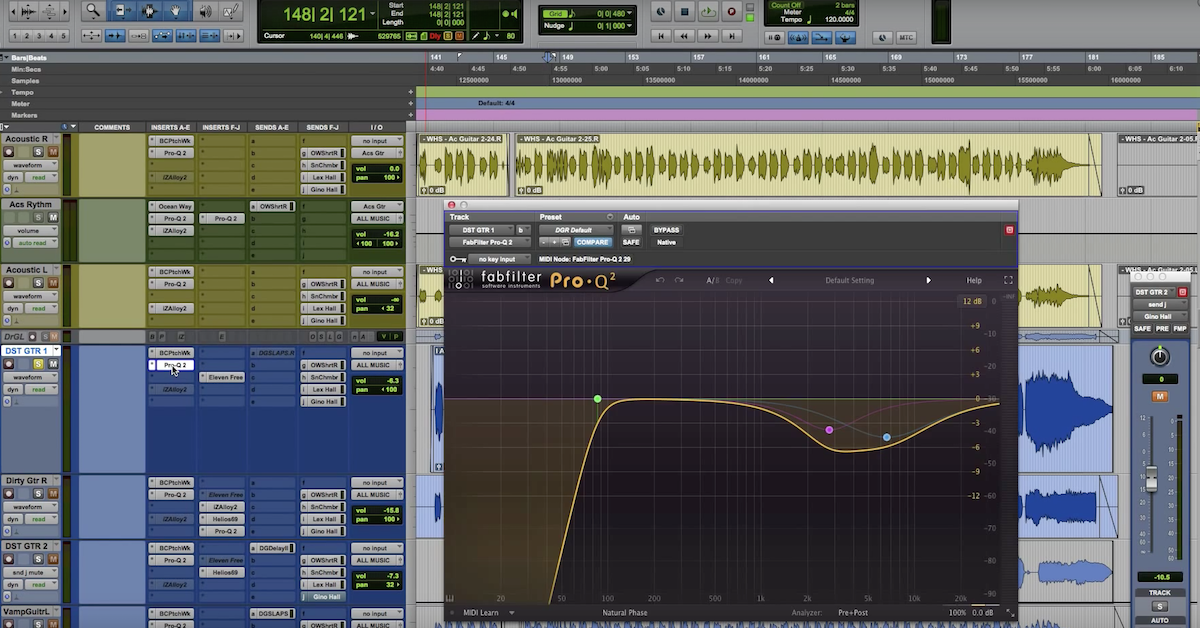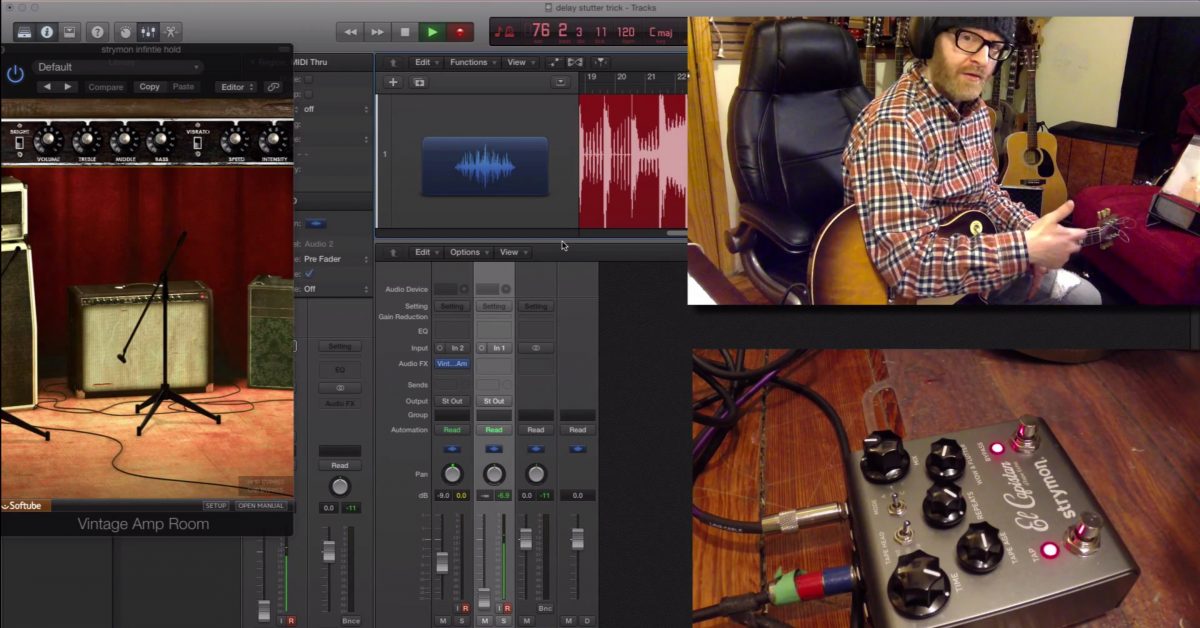How to Widen Electric Guitar with Delay, Mid-Side EQ and More
We’ve got another question from my friend Ron over at themixacademy.com. He’s a member over there. He asked, let’s pull open his e-mail as I stare at the screen. I’m going to pull it open here. He says, “Please go over your Kenny Gioia method of creating a widening effect using a delay. I personally think that this technique sounds better than using something like the Waves S1. What do you think?” Well, I think they’re different. It’s funny you say Kenny Gioia, I’m pretty sure he’s mentioning it because from time to time, I try to give credit where credit is due, and back years ago, Kenny was the creator of a thread over at The DUC, the AVID.DUC forum. It used to be Digidesign, and he had a tips and tricks forum where he just threw all kinds of gems. You can still go check that out, I think it’s still all up there.
A ton of us were throwing in tips and tricks and stuff, and one of them that I remember that I use all the time was a widening effect from using this mono-to-stereo delay, and so, I’m going to demonstrate that here.
You want to be careful with this one with phase and checking it, but if you are a fan of checking in mono, great, if not, whatever, but this is just going to be another tool to add to your arsenal of tools, and hopefully you dig it.
So, we’ve been working with these stereo guitars, but what I’m going to do now is get rid of – actually, let’s play the doubled sound. So, this is an actual set of doubled guitars right here, this clean.
[guitars play]
So, it was tracked once, tracked again, a little bit of differences between the two create that cool chorusing effect, a little bit of modulation between them naturally from the strings being hit at a little bit of a different time, a little bit of a different resonance from them.
Let’s say that we were only dealing with one guitar, but we wanted to create the effect of having two. A couple of ways we could do that. We could come in here and duplicate this track, duplicate everything about that track, so now we have an exact duplicate. We could break it, come in here, zoom in, and just shift it a little bit, and listen to that.
[guitars play]
Okay, and then depending on how far you shift it, you can go a little bit further. That’ll increase the width of the effect.
[electric guitars]
Now, we’ve kind of got a 32nd, 16th note vibe going on, so I’ll pull it back a little bit more, and that’s one way. So you can actually break it and slide the audio over – a duplicate of it.
We’re going to try it a different way. I’m going to make that inactive, and what Ron was asking about was the mono-to-stereo delay effect. Let’s just grab the stock delay and move the effect afterwards.
So now, we have a left and a right, and we’re going to make this work here. So we’ve got 250 on the left, I’m going to make that 35ms, and then on the right, I’m also going to do 35ms. I’m going to set the wet percentage of the left to 0%, so it’s not affecting the left side at all, but then the right, we’re going to have that 35ms delay.
So, let’s hear that panned down the middle and see what we get.
[guitar with delay]
Cool. So pretty similar, right? Now we’ve taken a mono source, given the impression of stereo. Not quite as… I don’t want to say valuable, beneficial, doesn’t sound as good… you could argue any of those depending upon what you’re going for, but it’s different. It’s another way to look at it, and very basically there’s that.
Now, you could also get in here with, say, like an MS EQ. Something I do quite often would be to come in and put this in MS mode, and then drag down this center band here – let’s go to stereo placement: mid, and let’s suck out some of the mids from this effect.
[guitar with delay]
So, we’ve created this hollow type sound. If I bypass it…
[guitar with delay]
Just another thing you could do to it. All kinds of stuff you can add to it, but at it’s very core, there’s that effect.
You may also try sending into this effect. So let’s create a new mono aux, and we’re going to do that same delay. Pull it back in. We’re going to send this to “all effects.” I’m going to create a new buss, we’ll go buss 25… Being all particular, I’m going to name it. We’ll call this KG spreader. How about that? What a name.
Okay, so the KG spreader is there, and we can come send this to the KG spreader. Pull it up, and like we talked about with our other video, we can take and set this to pre-fader, so now the signal is going to go into the spreader. I’m OCD here. Let’s label it. I’m going to solo-safe it.
Now let’s take a listen. We’re not going to hear any of this dry track – the original – we’re just going to hear the effect send.
[guitar with delay]
So, if you wanted to, you could pull that back down, get your dry signal rocking here…
[dry guitar plays]
And then you could blend some of this delayed signal.
[guitar with delay]
Versus the original untouched track.
[electric guitar]
Then don’t stop there. I love to come in here and add other effects.
Let me come in and put an EQ after this effect and take out some of the top end, maybe take out some of the stuff down low, maybe cut a bit of the mids where the vocal lives to make sure nothing gets real messy there, let’s add a bit of grit. I’ve got this new Waves Butch Vig thing that’s been a blast to work with, and I’m going to throw just some distortion/saturation into it. Pull up a little bit of each, and I’m doing this quickly, I’m going to cut some of the highs out of that, and let’s see what we get.
So there’s the original. Let me come over here and send it. Sorry guys, I’m moving quickly for you.
[guitar plays with double]
One more time.
[guitar plays with double]
So that’s kind of cool. Depending on the song, that might be a good deal. Let’s send to that Gino-hall that we talked about.
Now we’re only sending the spreaded signal to this Gino-hall. It sounds pretty sweet.
[guitar plays with double]
And you don’t have to stop there. You can come in here – I’m having some fun, let’s do one more. One of my favorite effects is the Plug-N-Mix Tremolo Pan. So let’s create a little bit of movement with this. Let’s keep the width down. Let’s do a vertical movement, and let’s see what we get from that.
Let’s sync it to the track, and go maybe a quarter note or something.
[guitar plays with tremolo]
That was a dotted eighth. Let’s go a quarter, I missed it there.
Maybe a triplet?
Maybe a sixteenth?
[electric guitar with tremolo]
Back off the depth a little bit for a subtle thing. Could be cool. We’re doing this all out of context with the mix, so you always want to make sure you get out of solo and see what it sounds like in the track if it’s helping the song, but there’s a few tips for working with some sends and working with that KG spreader! Thanks to Kenny Goya*** for hooking us up with all of the great stuff he shares.
Thanks Ron for the question. Go check out themixacademy.com if you want more exclusive tutorials like this. We’ve got a forum, we’ve got all kinds of stuff. Just $27 a month, start to finish mix videos, gaining access to the multi-tracks so you can mix it and use it for your resume to build up a sweet portfolio.
More of that over at themixacademy.com. Thanks again. David Glenn of theproaudiofiles.com.






